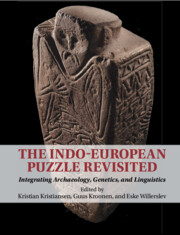Book contents
- The Indo-European Puzzle Revisited
- The Indo-European Puzzle Revisited
- Copyright page
- Contents
- Figures
- Tables
- Contributors
- Preface
- Introduction
- Part I Early Indo-European and the Origin of Pastoralism
- Part II Migratory Processes and Linguistic Dispersals between Yamnaya and the Corded Ware
- Part III The Cultural and Linguistic Significance of Bell Beakers along the Atlantic Fringe
- Part IV The Bronze Age Chariot and Wool Horizons
- Part V Kinship Systems, Marriage, Fosterage, Free, and Unfree
- 19 Mobility, Kinship, and Marriage in Indo-European Society
- 20 Marriage Strategies and Fosterage among the Indo-Europeans: A Linguistic Perspective
- 21 Fostering Women and Mobile Children in Final Neolithic and Early Bronze Age Central Europe
- 22 Hiding in Plain Sight? The Enigma of the Linguistic Remains of Prehistoric Slavery
- Concluding Reflections
- Index
- References
22 - Hiding in Plain Sight? The Enigma of the Linguistic Remains of Prehistoric Slavery
from Part V - Kinship Systems, Marriage, Fosterage, Free, and Unfree
Published online by Cambridge University Press: 29 April 2023
- The Indo-European Puzzle Revisited
- The Indo-European Puzzle Revisited
- Copyright page
- Contents
- Figures
- Tables
- Contributors
- Preface
- Introduction
- Part I Early Indo-European and the Origin of Pastoralism
- Part II Migratory Processes and Linguistic Dispersals between Yamnaya and the Corded Ware
- Part III The Cultural and Linguistic Significance of Bell Beakers along the Atlantic Fringe
- Part IV The Bronze Age Chariot and Wool Horizons
- Part V Kinship Systems, Marriage, Fosterage, Free, and Unfree
- 19 Mobility, Kinship, and Marriage in Indo-European Society
- 20 Marriage Strategies and Fosterage among the Indo-Europeans: A Linguistic Perspective
- 21 Fostering Women and Mobile Children in Final Neolithic and Early Bronze Age Central Europe
- 22 Hiding in Plain Sight? The Enigma of the Linguistic Remains of Prehistoric Slavery
- Concluding Reflections
- Index
- References
Summary
The present chapter discusses the linguistic evidence for slaves and slavery in Proto-Indo-European, with the Latin lexicon as its point of departure. Slavery, as such, has proven to be quite an elusive field of investigation. Archaeologists in particular have been perplexed to find that, even in historical periods for which literary sources richly document slavery as a vital institution, the archaeological evidence is meager and ambiguous. In a sense, slaves are as invisible to archaeologists as they were anonymous and socially nonexistent in the societies that they helped build and maintain. One of the keys to the archaeologist’s problem is that, being possessions themselves, slaves tend not to own anything, and, given that they are not legitimate members of society, they are not likely to receive elaborate burials – to the extent that they are buried at all. However, there are other scenarios in which the material wealth of slaves was in fact similar to that of lower-class free individuals, rendering it impossible to tell the classes of free and unfree workers apart. For overviews of the complexities of slavery in the field of archaeology, see, for instance, Marshall (2016: 69) and Morris (2018).
- Type
- Chapter
- Information
- The Indo-European Puzzle RevisitedIntegrating Archaeology, Genetics, and Linguistics, pp. 308 - 326Publisher: Cambridge University PressPrint publication year: 2023



